| Pages:
1
..
12
13
14
15
16
..
18 |
Morgan
International Hazard
    
Posts: 1660
Registered: 28-12-2010
Member Is Offline
Mood: No Mood
|
|
Here's a fused quartz sphere repurposed into a feeder. It's nice in that after you tap it to get the solution all the way down it stops dripping yet
continues to feed unlike most feeders that drip off and on. I have a pinhole in the top of a coke bottle and inverted it will drip constantly every
few seconds. Somehow air skirts in around the tiny hole. It's curious how some shapes won't work and others with 10 times as big a hole do. The nature
of surface tension, air bubbles, gravity, and partial vacuums makes for some challenging riddles on how liquids flow.
You can make reverse images with it or start a fire too, another use as a lens.
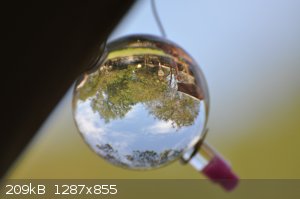 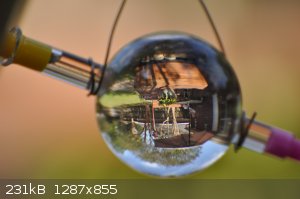 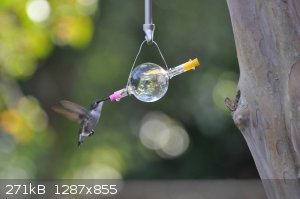
|
|
|
Morgan
International Hazard
    
Posts: 1660
Registered: 28-12-2010
Member Is Offline
Mood: No Mood
|
|
Yesterday I fiddled around in the garage and came across some magnet clamps purchased from Enco and thrift store stands bought a few years back. One
stand was from a fireplace utensil set where a stoker, broom, shovel and tongs hung from. Another some lamp base or such and another mystery stand.
The other parts are an old curtain rod I had with a curl or hook at the end, some V-shaped fixture that held a light bulb, and odd little square beam
clamps bought at a habitat for humanity store that accepts 1/4 20 screws in 3 places and a smaller screw in another plus some holes - maybe not all
that useful here, but an afterthought.
The last parts are some fixtures or branch pole things for the magnet bases that are all iron or steel except for the knobs that sleeve over nuts
underneath. In a way they are reminiscent of ring stand parts. Its curious how the outermost hole tightens first and then the inner, kind of unusual
to get used to. The outermost holes are two sizes if you have rods/poles that match the diameters.
https://www.bhphotovideo.com/c/product/1084866-REG/platinum_...
This hodgepodge isn't all that great or ideal, but was a start cobbled together from dissimilar parts just to see what might evolve.
Now to find some fingers of some sort I guess ...
The small 3-legged stand is another object bought at the thrift store and an old ~12 inch diameter glass stoplight lens which is now a little bird
bath.
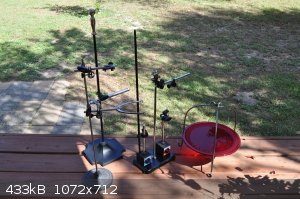 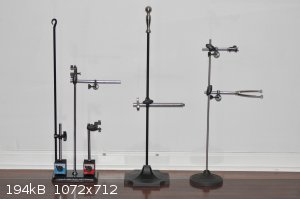 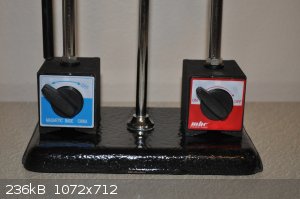 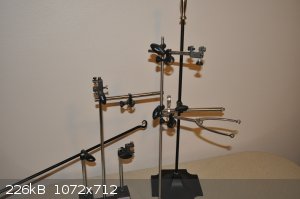
[Edited on 21-9-2019 by Morgan]
|
|
|
earpain
Hazard to Others
  
Posts: 102
Registered: 11-9-2019
Member Is Offline
|
|
This is a question I have faced a lot in my days of DIY glasswork.
1. With tubing or bottles/flasks, if you hold the bottle up to the light above you, so that the walls of the bottle are seen along your line of sight,
if you will see a green tint, it is soda-lime aka soft glass. If it still looks completely transparent with no color tint, it is likely boro.
Another test that is even more reliable:
Take two similar pieces of glass, one being the glass in question, the other being a piece that you know for sure is borosilicate. When i say
similar I mean, ends are both rod with similar diameter, or ends are both tube(mouth) with similar diameter and similar thickness.
Rotate both over a propane/mapp gas or oxy/propane torch and fuse them together properly like you would normally when creating a weld.
If the mystery piece is not borosilicate, basically upon cooling EVERYTHING in or near the joint will crack, pretty dramatically.
|
|
|
wg48temp9
National Hazard
   
Posts: 761
Registered: 30-12-2018
Location: not so United Kingdom
Member Is Offline
|
|
Quote: Originally posted by Morgan  | Here's a fused quartz sphere repurposed into a feeder. It's nice in that after you tap it to get the solution all the way down it stops dripping yet
continues to feed unlike most feeders that drip off and on. I have a pinhole in the top of a coke bottle and inverted it will drip constantly every
few seconds. Somehow air skirts in around the tiny hole. It's curious how some shapes won't work and others with 10 times as big a hole do. The nature
of surface tension, air bubbles, gravity, and partial vacuums makes for some challenging riddles on how liquids flow.
You can make reverse images with it or start a fire too, another use as a lens.
|
There should be a law about that, using a fused quartz flask as a bird feeder should be criminal especially for sm members LOL  
I am wg48 but not on my usual pc hence the temp handle.
Thank goodness for Fleming and the fungi.
Old codger' lives matters, wear a mask and help save them.
Be aware of demagoguery, keep your frontal lobes fully engaged.
I don't know who invented mRNA vaccines but they should get a fancy medal and I hope they made a shed load of money from it.
|
|
|
wg48temp9
National Hazard
   
Posts: 761
Registered: 30-12-2018
Location: not so United Kingdom
Member Is Offline
|
|
Quote: Originally posted by earpain  |
This is a question I have faced a lot in my days of DIY glasswork.
1. With tubing or bottles/flasks, if you hold the bottle up to the light above you, so that the walls of the bottle are seen along your line of sight,
if you will see a green tint, it is soda-lime aka soft glass. If it still looks completely transparent with no color tint, it is likely boro.
|
I have re-purposed bulb growing glasses and coffee beakers because they looked looked clear with no green tint. I placed one of the bulb growing
glasses containing a coolish solution on a temperature controlled hot plate (~80C) and it cracked across the base. That suggests its not boro.
A few days ago I purchased some glass coffee mugs from a charity shop. The first one I examined appeared clear but the second identical one had a very
distinct green tint.
Expensive bottles of clear spirits tend to not to have significant green tints and decorative glass items tend to be clear almost no green tint.
You can probably be confident (>90%) that if there is a green tint its not boro. But if its clear its very weak evidence that it is boro.
I am wg48 but not on my usual pc hence the temp handle.
Thank goodness for Fleming and the fungi.
Old codger' lives matters, wear a mask and help save them.
Be aware of demagoguery, keep your frontal lobes fully engaged.
I don't know who invented mRNA vaccines but they should get a fancy medal and I hope they made a shed load of money from it.
|
|
|
Morgan
International Hazard
    
Posts: 1660
Registered: 28-12-2010
Member Is Offline
Mood: No Mood
|
|
My repurposed synthetic ruby rod/hummingbird perch passed the test today. The rod is supported by 2 clear fused quartz tubes with blue silicone tubing
and the male ruby-throated hummingbird is sipping from a borosilicate drinking straw. Only when he ruffles his feathers or the sun hits him just right
can you see his iridescent ruby throat.
The perch was fashioned after seeing a simple design such as this. I happened to have an odd single red wooden ball in the garage which was fortuitous
and the ruby rod bought on eBay years ago.
https://www.bestnest.com/bestnest/RTProduct.asp?SKU=SOE-SEHH...
https://www.sibleyguides.com/2011/09/the-basics-of-iridescen...
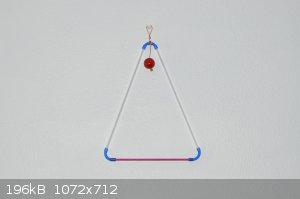  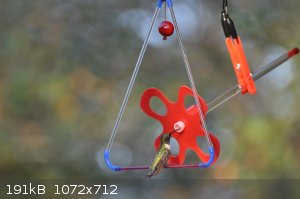 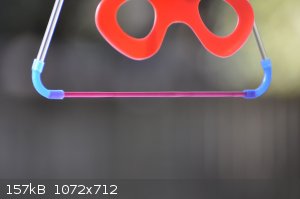
[Edited on 28-9-2019 by Morgan]
|
|
|
earpain
Hazard to Others
  
Posts: 102
Registered: 11-9-2019
Member Is Offline
|
|
Quote: Originally posted by wg48temp9  | Quote: Originally posted by earpain  |
This is a question I have faced a lot in my days of DIY glasswork.
1. With tubing or bottles/flasks, if you hold the bottle up to the light above you, so that the walls of the bottle are seen along your line of sight,
if you will see a green tint, it is soda-lime aka soft glass. If it still looks completely transparent with no color tint, it is likely boro.
|
I have re-purposed bulb growing glasses and coffee beakers because they looked looked clear with no green tint. I placed one of the bulb growing
glasses containing a coolish solution on a temperature controlled hot plate (~80C) and it cracked across the base. That suggests its not boro.
A few days ago I purchased some glass coffee mugs from a charity shop. The first one I examined appeared clear but the second identical one had a very
distinct green tint.
Expensive bottles of clear spirits tend to not to have significant green tints and decorative glass items tend to be clear almost no green tint.
You can probably be confident (>90%) that if there is a green tint its not boro. But if its clear its very weak evidence that it is boro.
|
Hmm, you may be indeed be correct, and I'll have to revise my system.
An example that neither contradicts nor supports your claim(or mine):
Candy thermometers. $3-$5 at the food store. There's no kitchen thermometer sold that has such a wide range of temps. I have bought them before,
removed the metallic element fused to the glass on the bottom, along with the capillary tube that shows the temperature, and then worked the remaining
wide, but very very thin walled tube.
If it is borosilicate, once I'm both flame working and turning it into various devices, or auxillary glassblowing devices(temporary handle, extension
tube, etc.) - it is the WORST I've ever worked with. I have flameworked soft/flint glass more reliably than these thermometers.
I suppose there is an application in mind when a glassware is designed. All glass that is not quartz has something added to it mostly just to lower
its working temperature, not everyone has Oxy-Acetylene or mega-kilns handy.
Perhaps the non-green tinted glass that cracked on you, cracked for reasons unrelated to what metals or salts were added to the glass 'stew'? Like
with candy thermometers. Surely they must technically be borosilicate. Not sure why they are so finicky.
3 general types of clear glass(in terms of material):
soda-lime
borosilicate
quartz(aka SiO2, no additives)
And then there's a plethora of structural factors, and considerations for the items application. In general I would discourage chemists to repurpose
or DIY glassware unless they also have some proper training in glasswork. Scientific glass is definitely the most versatile and robust.
|
|
|
wg48temp9
National Hazard
   
Posts: 761
Registered: 30-12-2018
Location: not so United Kingdom
Member Is Offline
|
|
Here is a pic of the two coffee glasses side by side. The green tint of the right hand one is distinct. Of cause although they looked identical and
come with identical metal housings (removed for the pic) I am not certain they are. I also swapped the position of the glasses incase the green tint
was from a nearby object.
This is weak evidence as I am assuming they are identical as they were purchased together. Apparently the the green color comes from iron impurities
in the material used to make the glass. So these must have been made from different batches of material.
This particular green tint seems more emerald green than the dull green tint I usually see in bottle glass.

Here is a pic of two tall vases and a boro 2l measuring cylinder from Fisher Scientific (right lower). All three are about 0.8m tall. The left hand
vase is dark with a hint of green, the top vase has a slight dull green tint and the boro cylinder is lighter with almost no color. I assume the
vases are soda glass. All three appear clear when viewed from the side.
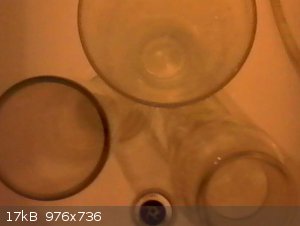
Sorry the pic is poor quality it was taken under fluorescent lighting in the bathroom having just rinsed off the dust.
PS I got lucky when I won the measuring cylinder on ebay no one else bid on it so it was very cheap. Its very impressive given it is almost a meter
long. I am still trying to buy a stopper for it that does not cost more than I paid for it.
[Edited on 10/1/2019 by wg48temp9]
I am wg48 but not on my usual pc hence the temp handle.
Thank goodness for Fleming and the fungi.
Old codger' lives matters, wear a mask and help save them.
Be aware of demagoguery, keep your frontal lobes fully engaged.
I don't know who invented mRNA vaccines but they should get a fancy medal and I hope they made a shed load of money from it.
|
|
|
Yttrium2
Perpetual Question Machine
    
Posts: 1104
Registered: 7-2-2015
Member Is Offline
|
|
Anyone know of where to find borosilicate bulbs/tubes?
Besides HID lighting -- for a diy flask
|
|
|
earpain
Hazard to Others
  
Posts: 102
Registered: 11-9-2019
Member Is Offline
|
|
Do NOT buy from Chemistry Equipment vendors.
Do not buy from coffee shops with their new boro glass straw trend($5 for 8in tube)
Just buy from these guys:
https://www.mountainglass.com/boro-glass-33-coe/clear
or any supplier specializing in customers who are -glass blowers-
Seriously the link above, I challenge anyone to find a cheaper deal. Disregard everything besides the Boro tubing and the ground glass joints(no
24/40 though -/)
|
|
|
Eisenpanzer432
Harmless

Posts: 7
Registered: 9-2-2018
Member Is Offline
Mood: No Mood
|
|
DavidJR hey I forgot I posted this haha. I painted it and then reduced the size to fit in my hood I’m building. It will be able to fit into slots
and clamp or pin in place, so I can remove it if I need to clean or make more room in the hood. It’ll be a while, hopefully not another year lol;
I’m still deciding what to make the sash from before I build. I may use plexiglass with bending hinges at two points to give three sections that I
can fold up or down to change the height of the sash; I’m limited on vertical space. I’ll have straps on the sides of the plexi to pull tight
against caulk or foam to seal the sides of the plexi agains the sides of the hood when it’s folded down. I hope that makes sense; perhaps a picture
will be needed when it’s complete.
|
|
|
SWIM
National Hazard
   
Posts: 970
Registered: 3-9-2017
Member Is Offline
|
|
Quote: Originally posted by wg48temp9  |
PS I got lucky when I won the measuring cylinder on ebay no one else bid on it so it was very cheap. Its very impressive given it is almost a meter
long. I am still trying to buy a stopper for it that does not cost more than I paid for it.
[Edited on 10/1/2019 by wg48temp9] |
Sometimes big adaptors are cheaper than big stoppers.
I've got a few items where I use like a 24/40 to 55/50 adaptor with a 24/40 stopper in the top instead of a 55/50 stopper.
Less then Ideal, but better than nothing.
What size are you after?
EDIT: On another front, I believe that testing the index of refraction might be a good easy way to find boro glass.
A solution with the same index of refraction as boro would make it easy.
Just put glass in solution and see if it disappears.
[Edited on 20-12-2019 by SWIM]
|
|
|
Morgan
International Hazard
    
Posts: 1660
Registered: 28-12-2010
Member Is Offline
Mood: No Mood
|
|
Quote: Originally posted by wg48temp9  | Quote: Originally posted by earpain  |
This is a question I have faced a lot in my days of DIY glasswork.
1. With tubing or bottles/flasks, if you hold the bottle up to the light above you, so that the walls of the bottle are seen along your line of sight,
if you will see a green tint, it is soda-lime aka soft glass. If it still looks completely transparent with no color tint, it is likely boro.
|
I have re-purposed bulb growing glasses and coffee beakers because they looked looked clear with no green tint. I placed one of the bulb growing
glasses containing a coolish solution on a temperature controlled hot plate (~80C) and it cracked across the base. That suggests its not boro.
A few days ago I purchased some glass coffee mugs from a charity shop. The first one I examined appeared clear but the second identical one had a very
distinct green tint.
Expensive bottles of clear spirits tend to not to have significant green tints and decorative glass items tend to be clear almost no green tint.
You can probably be confident (>90%) that if there is a green tint its not boro. But if its clear its very weak evidence that it is boro.
|
Maybe of interest to test green tinted and clear samples using this method to see what comes about.
Index of Refraction - disappearing glassware demonstration // Homemade Science with Bruce Yeany
https://www.youtube.com/watch?v=9Tj2KMZhfoc
"You can make Pyrex glass disappear by immersing it in glycerin or mineral oil. However, mineral oil comes in different weights, and each variety has
a different index of refraction. To match the index of refraction of Pyrex glass, you’ll need a mixture of mineral oils of different weights. To
create the proper mixture, place a Pyrex glass object into a large glass beaker and pour in enough heavy mineral oil to submerge it partially. Slowly
add light mineral oil and stir. Watch the glass object as you pour. Most Pyrex glass will disappear when the mixture is two parts heavy mineral oil to
one part light mineral oil. Notice the swirling refraction patterns as you mix the oils."
https://www.exploratorium.edu/snacks/disappearing-glass-rods
|
|
|
wg48temp9
National Hazard
   
Posts: 761
Registered: 30-12-2018
Location: not so United Kingdom
Member Is Offline
|
|
Quote: Originally posted by SWIM  | Quote: Originally posted by wg48temp9  |
PS I got lucky when I won the measuring cylinder on ebay no one else bid on it so it was very cheap. Its very impressive given it is almost a meter
long. I am still trying to buy a stopper for it that does not cost more than I paid for it.
[Edited on 10/1/2019 by wg48temp9] |
Sometimes big adaptors are cheaper than big stoppers.
I've got a few items where I use like a 24/40 to 55/50 adaptor with a 24/40 stopper in the top instead of a 55/50 stopper.
Less then Ideal, but better than nothing.
What size are you after?
EDIT: On another front, I believe that testing the index of refraction might be a good easy way to find boro glass.
A solution with the same index of refraction as boro would make it easy.
Just put glass in solution and see if it disappears.
[Edited on 20-12-2019 by SWIM] |
Its a 45/50. There are adapters on ebay that are 45/50 but they cost about £50. I have now won some blocks of PTFE so when I get round to fixing
my old lathe I will turn a stopper and adaptor for for it. Not that I have a particular use for it at this time.
Yes a matched index may work for a small object but how do you test a 2l measuring cylinder and will it have the discrimination? Pyrex is 1.47
window glass is 1.52.
Perhaps a type of refractometer can be used on flat-ish area of one side
of the glass object but the cheap reflectometers are for use with liquids.
I am wg48 but not on my usual pc hence the temp handle.
Thank goodness for Fleming and the fungi.
Old codger' lives matters, wear a mask and help save them.
Be aware of demagoguery, keep your frontal lobes fully engaged.
I don't know who invented mRNA vaccines but they should get a fancy medal and I hope they made a shed load of money from it.
|
|
|
Morgan
International Hazard
    
Posts: 1660
Registered: 28-12-2010
Member Is Offline
Mood: No Mood
|
|
That does seem difficult to submerge that large object. Maybe just an edge of the flange at the base would be enough to reveal a disappearance. And
still as you say the numbers are close to window glass. I was reading quartz is close to borosilicate too,
coming in at 1.458 to boro's 1.474 refractive index.
https://glassshop.yale.edu/helpful-glass-facts
I bought an oil candle lamp and was wondering what it was made of, the copy referred to it as a crystal oil lamp. Not caring enough yet to test it
with oil and having to wash it out I unconventionally heat stressed it enough to burn a spot on a violet colored silicone pad underneath it, right in
the bottom center where the direct flame pushes the alcohol off to the sides. In that test it ran well over a minute. While not conclusive it was a
positive outcome and you could feel the heat radiating from it after it had nearly run dry.
Having bought small new borosilicate bottles and vials, and the oil lamp for example there is a certain look to the glass, as if it has a kind of
glossiness or ultra smoothness to it, maybe like a glazed appearance. Of course this might just be my subjective imagination or that other glasses
could emulate the effect.
The candle oil lamp, just shaking water out of it takes some time to empty it, the hole a little over 8 mm. This was just a first test.
https://www.youtube.com/watch?v=KLgjG5b79yQ
As a safety aside, on the Princess oil lamp on an eBay offering, there was some literature or warnings that came with it.
"Use only lamp oil. Do not use gasoline, alcohol, or solvents as fuel in this or any other oil lamp. Failure to follow these instructions may cause
fire or explosion which could result in property damage or serious personal injury from cuts or burns."
The lamp is a thin glass, very much like the cylindrical borosilicate food storage jars with bamboo lids sold on eBay. But maybe it's lead crystal.
[Edited on 20-12-2019 by Morgan]
|
|
|
Morgan
International Hazard
    
Posts: 1660
Registered: 28-12-2010
Member Is Offline
Mood: No Mood
|
|
Tidbits on thermal expansion properties of glass - scroll down for each type of glass.
Also maybe of interest
"Thermal conductivity of glasses typically varies between 0.5 – 1.5 W/(m K), the highest being for fused silica and lowest for lead glass. The
thermal conductivity measurement is complicated because heat is also transferred internally by radiation. The thermal conductivity is non-linear,
increasing with temperature. And, as for any processed material, the exact compound and the processing parameters affect the thermal properties
significantly, causing the literature values to vary widely."
Glass: A Group Of Familiar Materials With Varying Properties
https://www.electronics-cooling.com/2003/02/glass-a-group-of...
|
|
|
mayko
International Hazard
    
Posts: 1218
Registered: 17-1-2013
Location: Carrboro, NC
Member Is Offline
Mood: anomalous (Euclid class)
|
|
| Quote: |
Many scientists will go out of their way to save a few bucks, especially when it comes to improvising with makeshift lab equipment. So when Jacquelyn
Gill, an associate professor of paleoecology and plant ecology at the University of Maine, asked on Twitter what everyday household items scientists
use for research, she got hundreds of responses.
“When I was a student we used to use a salad strainer to centrifuge crystallization capillaries,” tweeted Tamir Gonen, a professor of biological
chemistry and physiology at the University of California, Los Angeles.
Tom Rivas, a graduate student in biochemistry at the University of Colorado Boulder, could identify with that, tweeting that he uses a salad spinner
to pulse down his quantitative polymerase chain reaction plates before running them.
“Nail salon lamps for photochemical reactions and cat litter buckets for base baths,” offered Lisa McElwee-White, a chemistry professor at the
University of Florida. “And an aquarium pump in a styrofoam beer cooler full of ice water makes a great circulating chiller.” She points out that
a chiller can cost a few thousand dollars, whereas a Styrofoam beer cooler can be purchased for as low as $1 from a convenience store.
|
https://cen.acs.org/people/Scientistsfavorite-DIY-lab-equipm...
al-khemie is not a terrorist organization
"Chemicals, chemicals... I need chemicals!" - George Hayduke
"Wubbalubba dub-dub!" - Rick Sanchez
|
|
|
j_sum1
Administrator
       
Posts: 6218
Registered: 4-10-2014
Location: Unmoved
Member Is Offline
Mood: Organised
|
|
Simple burette stand...
Sorry no photo. It as not possible for me to et an angle that showed the whle thing clearly.
My lab has a rather low ceiling and my bench is high. I cut a length of wooden dowel, drilled a hole through it and attached by a nail to one of the
joists above the bench. It hinges so that it can hang down or be hooked up out of the way when not in use. A simple bulldog clip is screwed onto the
dowel to hold a burette. (Actually two bulldog clips for two different diameters.)
Voila, a burette stand. Except there is absolutely no chance of knocking it over. It has zero footprint n the bench top: if there is a spill or
dribble then I can wipe it up without moving anything. (Ever try to fill a burette or sep funnel without closing the stopper?) Works beautifully.
|
|
|
mayko
International Hazard
    
Posts: 1218
Registered: 17-1-2013
Location: Carrboro, NC
Member Is Offline
Mood: anomalous (Euclid class)
|
|
| Quote: |
OK gather round kids I’m going to tell you a true chemistry lab story about how a sex toy became a key part of a nuclear disarmament program. ...
you work in glove boxes behind walls of lead bricks and everything has to be cleaned out easily, like stripped out, as you don’t want to die. And
part of the process they are doing is to shake the vial. Now, behind lead bricks with thick rubber gloves on shaken ain’t easy. So how do they get
around this obstacle?
And one genius goes: “I KNOW! AN ANAL VIBRATOR!” It’s small, it’s wipe clean, it is cheap to replace and it vibrates. Just the ticket. ... AND
THUS a young grad student ventured into town. Into the red light district. Into the sex shop. And slid that backdoor wiggler over the counter, smiled,
and said: “I’m very sorry, but my anal vibrator had broken after 45 minutes of continuous use, please may I get a replacement?”
|
https://twitter.com/ChemistryKit/status/1253812286801747969
 
al-khemie is not a terrorist organization
"Chemicals, chemicals... I need chemicals!" - George Hayduke
"Wubbalubba dub-dub!" - Rick Sanchez
|
|
|
arkoma
Redneck Overlord
      
Posts: 1761
Registered: 3-2-2014
Location: On a Big Blue Marble hurtling through space
Member Is Offline
Mood: украї́нська
|
|
Quote: Originally posted by j_sum1  |
Voila, a burette stand. Except there is absolutely no chance of knocking it over. It has zero footprint n the bench top: if there is a spill or
dribble then I can wipe it up without moving anything. (Ever try to fill a burette or sep funnel without closing the stopper?) Works beautifully.
|
Beautiful. The swing up idea. And yes, not had the stopcock closed and/or not tightened up more than I care to admit.
"We believe the knowledge and cultural heritage of mankind should be accessible to all people around the world, regardless of their wealth, social
status, nationality, citizenship, etc" z-lib
|
|
|
Refinery
Hazard to Others
  
Posts: 371
Registered: 17-2-2014
Member Is Offline
Mood: Still
|
|
Storage matters.
The chemical bottles can be more expensive than what's in them, 2-liter bottle can cost 20$ apiece, so many amateurs use all kinds of containers from
mason jars upto.
The problem is, their enclosure devices are usually not suitable for anything more hazardous than jello. When I was younger and more keen and less
careful, I actually managed to get one jar cap simply corrode away and find that the fumes corroded everything around them in the closet.
Rubber, silicon, PVC and other soft seal materials can withstand surprisingly few chemicals and they are useable mostly for the solid, stable stuff
that do not decompose, but for everything else, more robust solution is needed.
This issue was easily solved by cutting pieces from plastic membrane. Luckily, Polyethene is one of the most resistant plastics and at the same time
one of the most common ones, and it can withstand pretty much all common chemicals. As it happens, most plastic bags and other films are made out of
it, so just simply closing the container and cutting off excess can be enough to proof the jello can for your toxins.
For the most harsh stuff, ordering PTFE film can solve the issue. Being not as flexible, one can cut proper size seal cap to fit inside the cap, and
leave it there. It seals against glass, so there will be no other surfaces for the chemical to eat.
|
|
|
Refinery
Hazard to Others
  
Posts: 371
Registered: 17-2-2014
Member Is Offline
Mood: Still
|
|
To be honest, I've been using 10 liter plastic PE buckets as beakers for a few projects. They stand up many chemicals at NTP and they do not interfere
with magstirring and they can be easily tapped or drained.
Other project, making some acetates, I was discouraged by the odor, so I placed plastic wrap foil on top of a kettle, and cut and fixed two plastic
bottles to the kitchen fume hood over the stove so it created suction that carried all the steam and odors out. It worked out perfectly and zero
odors.
|
|
|
Mateo_swe
National Hazard
   
Posts: 501
Registered: 24-8-2019
Location: Within EU
Member Is Offline
|
|
Im interested in building a DIY ultrasonic generator for chemical experiments.
Anybody tried to build something like that here?
I found this technical paper PDF that seem to be a good design except i probably use PWM for the power level adjustment and not a controllable DC
power supply as they use in the paper.
The design continuously adjust the frequency to apply ultrasound at optimal resonant frequency.
It would be interesting if anybody has done something similar.
I include the technical paper on the ultrasonic generator if anybody is interested.
Attachment: Design of a intellectualized ultrasonic generator.pdf (1.4MB)
This file has been downloaded 503 times
|
|
|
earpain
Hazard to Others
  
Posts: 102
Registered: 11-9-2019
Member Is Offline
|
|
Devil's in the Details - Simplicity is Essence
So I broke all of my 24/40 flasks , all but exactly two. I did feel a foreshadowing of some greater wisdom as I saved as many female ground glass
joints as I could.
After buying a whole mountain of Pyrex brand Erlenmeyer's for $10 from some woman in my city, what I have been trying to achieve with glass blowing,
silicone casting, copper-to-glass, etc. etc. I finally achieved.
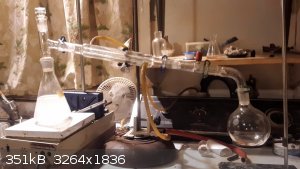
This is an airtight distillation (azeotropic, caustic, ethanol), with an old Pyrex brand 500ml Erlenmeyer, with just a standard erlenmeyer neck.
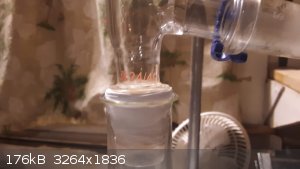
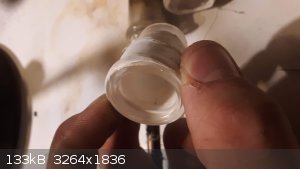
So here's what I did:
Upon breaking a vessel, I use to try to salvage as much ADDITIONAL glass beyond the female ground glass joint. In this case, I used my faithfull
diamond wheel to cut right along the seem where the female joint's cone is at its shortest, right before the actual flask begins.
Even before the teflon tape, I dropped it into the neck of several of my erlenmeyers, and it almost made a perfect seal as is. It's moments like
these that remind me that I don't just love teflon tape, I am IN LOVE with teflon tape.
One more pic, showing a failure, the same success, and a future work in progress
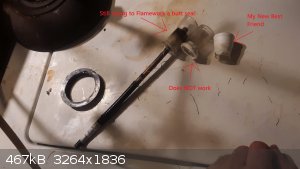
|
|
|
Syn the Sizer
National Hazard
   
Posts: 591
Registered: 12-11-2019
Location: Canada
Member Is Offline
|
|
Great idea, I recently broke my 105o adapter with vacuum takeoff, I have been holding onto it in case I figured something out with it. I
now plan on cutting the female adapter off. I have also considered keeping the male adapters to see if I can use the somewhere.
|
|
|
| Pages:
1
..
12
13
14
15
16
..
18 |